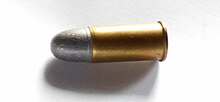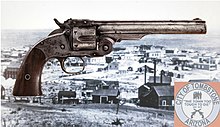Smith & Wesson No. 3
The Smith & Wesson Model No 3 was the first revolver with a tiltable barrel and a mechanical ejection of the fired cases. It was also the first large-caliber revolver manufactured by the Smith & Wesson company from 1870 onwards . It replaced the first cartridge revolver manufactured by the company with a hinged barrel and loose drum, the Smith & Wesson No 1 and its successors.
history
Between 1856 and 1872, through a contract with Rollin White , Smith & Wesson had an exclusive license to manufacture pierced drum revolvers. Because of this license, Colt and Remington were not allowed to produce such cartridge revolvers. Colt tried the conversion to the Colt Thuer revolver , in which the cartridges were pressed from the front into the drum closed at the back, the Remington company acquired a license from S&W to manufacture rear-loading conversion kits for their percussion revolvers .
With the introduction of the Smith & Wesson No 1, which was produced from 1856, and its successor, the Smith & Wesson No. 2 Army , in .32 caliber with a hinged barrel and the use of rimfire cartridges, Smith & Wesson was the first manufacturer of cartridge revolvers in the USA. The system of these small-caliber revolvers with a hinged barrel, in which the drum had to be removed to remove the fired cases and for reloading, was not suitable for mounted personnel. The company therefore manufactured a .44 Henry revolver with a rigid frame in 1865 .
The next step was the development of a revolver in which the barrel and drum could be tilted for reloading in one unit, while the fired cases were ejected at the same time.
To eliminate competition, Smith & Wesson acquired existing patents for a barrel and drum tilting system (Pat. Abraham J. Gibson, July 10, 1860), a case ejection system (Pat. WC Dodge, Jan. 17 and 24, 1860). 1865) and a system for rotating the drum (Pat. Louis Rodier, July 11, 1865) and applied for patent protection in the USA and UK for their newly developed revolver. London granted the patent in April 1869. The US patent dated August 24, 1869 went to Charles A. King, operations manager at S & W and the main developer of the No. 3 revolver.
For the company, the name was S&W Revolver Model No. 3 not the model name, but the internal name of the large-caliber frame. On the market, this gave rise to the name of the entire series of large-caliber “single-action” drop barrel revolvers, which were manufactured until the beginning of the 20th century.
Functional features
Model No 3 was manufactured exclusively as a single-action revolver. The drum held six rounds. The system and the drum could be opened by lifting the lock above the tap. If the barrel was tilted forward by more than 90 degrees, a mechanism would drive a star-shaped case extractor in the middle of the drum, and the empty cases were pulled out at the edge of the case. When the barrel was pulled back to an angle of about 45 degrees, the extractor returned to its starting position and the drum could be loaded. You closed the barrel again and the weapon was ready to fire.
The dump barrel mechanics were later adopted by many other weapons manufacturers and used well into the 20th century (e.g. Webley and Enfield from Great Britain).
From 1880 Smith & Wesson also manufactured various Smith & Wesson Double Action break-open revolvers in various calibers. At the turn of the century, these were replaced by the "S&W Hand Ejector models" with a swing-out drum, which are still manufactured today.
The main models
American model
The first .44 Henry revolvers were completed in May 1870 and sent to the responsible authorities of the United States Army for inspection. These provided the superiority of the gun firmly over all previously tested turret, but recommended the amendment of rimfire to centerfire ammunition . At the end of 1870 the Army ordered 1000 of these S&W Model No. 3 First Model Single Action Revolver with a barrel length of 8 inches, in caliber .44 S&W American (other designation .44 / 100).
A total of around 8,000 pieces of the S&W No 3 First Model were produced, a few also for the .44 Henry rimfire cartridge. These weapons, manufactured up to serial number 38,000, were continuously improved and, along with the Colt Peacemaker, became the best-selling revolvers in the Wild West . Many law enforcement officers, as well as cowboys and gunslingers , used this model. With the weapons later manufactured for the .44 Russian cartridge, around 120,000 pieces of the S&W Model No. 3 produced.
One can therefore equate these weapons with the much better known Colt Peacemaker (around 350,000 of these were produced up to 1940). Thus, the Smith & Wesson No 3 also claims the predicate: “The gun that won the West”.
Russian model
A copy of the American Model Revolver in caliber .44 S&W American also went to the Russian military attaché , Alexander Gorlow . Russia showed interest and in the course of time ordered a large number of these revolvers for a somewhat modified ammunition, the .44 Russian . Like the .44 S&W American, it was a center fire cartridge, but the slightly larger case diameter required a stepped drum bore. The more than 130,000 weapons delivered to Russia had Cyrillic barrel markings. They were produced in different versions, the trigger guard was later given an additional hook and the shape of the handle was changed. It is interesting that a late version of the S&W Russian Model was manufactured by the German company Ludwig Loewe & Co. in Berlin and delivered to Russia.
Business with Russia established Smith & Wesson as an international company, and success was inevitable in America. The S&W No. 3 Russian Model and its successors, also as double-action models, were produced in large numbers up into the twentieth century and only replaced by the S&W hand ejector models with a swiveling drum.
Schofield model
This model is a further development of the S&W Model No. proposed for the U.S. cavalry by Major George W. Schofield, brother of General John M. Schofield . 3. The main change is in the barrel lock, which is attached to the frame instead of the barrel.
On Sept. 8, 1874, Smith & Wesson and the US Army signed an initial contract for the supply of 3,000 of these revolvers. In total, the US cavalry bought around 7,000 units of the first and second, improved variant. Since the barrel of the Schofield revolver was too short for the orderly cartridge .45 Long Colt , logistics problems arose. From 1875 a shorter and weaker unit cartridge was therefore issued. The troops also criticized the fact that the revolver ejected all cartridges when reloading, especially on horseback, whether fired or not. With the Colt, the empty cases could be ejected individually. That was important because a soldier was only equipped with 18 revolver cartridges and 50 rifle cartridges. For these reasons, the Schofield was retired and sold to the civilian market as early as 1880 or given to National Guard units. An important customer was the Wells Fargo Express Company, which purchased these revolvers with barrels shortened to 5 inches for their agents. These Schofields marked with -WF & Co's Ex- are sought-after collector's items today.
Smith & Wesson No. 3 New Model
When sales to the Russian Army decreased, the Model No. 3 further developed by IH Bullard, engineer at Smith & Wesson. The ejection mechanism has been simplified, the drum lock has been improved and the shape of the handles has been adapted. The production of the New Model No. 3 began in 1878. Initially, it was primarily manufactured in .44 Russian caliber for the civilian American market. A large number of these revolvers in the same caliber went to the Japanese Navy , the American Coast Guard , to Australia and Argentina. From 1879 5,000 .44 Henry revolvers were sold to Turkey.
From 1879, a revolver rifle in .320 caliber with barrel lengths of 16, 18 and 20 inches was also manufactured on the same frame. These rifles came with a removable butt.
In order to have a weapon on offer that fires the .44-40 WCF and .38-40 WCF cartridges that can be used for revolvers and rifles, like the “COLT FRONTIER SIX SHOOTER”, which was offered from 1878 , Smith & Wesson brought that in 1885 New Model Frontier in the same calibers on the market. Since the cartridge is longer than the drum of the S & W No. 3 models produced up to that time, the frame and drum had to be lengthened.
Smith & Wesson No. 3 target model
In 1887, the Target model was introduced in calibers .32-44 and .36-44. Target is a special development for target shooting . This model was the first S&W revolver on the market with an adjustable sighting device (in contrast to all standard revolvers, which have a rigid sight).
literature
- Norm Flayderman: Flayderman's Guide to Antique American Firearms . Krause Publications, Iola, WI 1971, ISBN 0-87349-313-3 .
- Roy G. Jinks: Smith & Wesson, a company with a history . Stocker-Schmid, Dietikon, Switzerland 1979, ISBN 3-7276-7025-8 .
Web links
- Smith & Wesson Model 3 revolver. In: ammoland.com. Retrieved October 31, 2017 .










